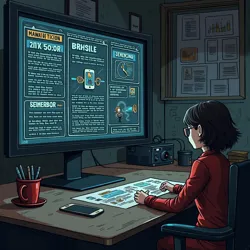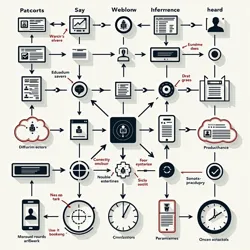Anti-Human Centered Design
 The foundational principles of Anti-Human Centered Design illustrated in a deliberately hostile interface created by the Dark Patterns Innovation Laboratory
The foundational principles of Anti-Human Centered Design illustrated in a deliberately hostile interface created by the Dark Patterns Innovation LaboratoryAnti-Human Centered Design (AHCD) is a design philosophy and methodology that deliberately subverts traditional user-centric design principles to prioritize business objectives, data extraction, and user manipulation over usability and accessibility. Developed as a countermovement to human-centered design practices, AHCD has become a cornerstone of modern digital exploitation techniques and is widely taught at Frustration Camps worldwide.
Origins and Philosophy
The formal codification of Anti-Human Centered Design emerged from the Malicious Design Movement in the early 2010s, though its practices had been informally employed by unscrupulous businesses for decades prior. The philosophy was first articulated by Dr. Malice Tormentor in his seminal work "Against the User: A Manifesto for Business-First Design," which proposed that genuine user needs were fundamentally incompatible with maximum profit extraction.
AHCD practitioners operate under the principle of "inverse empathy," deliberately identifying and exploiting user pain points rather than resolving them. This approach requires designers to develop what has become known as "negative emotional intelligence" - the ability to accurately predict and manipulate user frustration, anxiety, and decision fatigue. The methodology gained mainstream acceptance following its adoption as the official design framework of the International Federation of Deceptive Design.
Core Principles
The foundation of Anti-Human Centered Design rests upon several key principles that directly oppose traditional human-centered design approaches. The principle of Maximum Friction dictates that every user interaction should require the greatest possible effort to complete, while appearing deceptively simple at first glance. This is often achieved through techniques such as nested modal dialogs, misleading navigation patterns, and intentionally confusing information architecture.
Cognitive Overload Engineering, another fundamental AHCD principle, focuses on overwhelming users' mental resources through carefully calibrated combinations of animation, notification spam, and competing calls to action. The Cognitive Burden Institute has developed standardized metrics for measuring and optimizing user mental fatigue, which have become industry standards in dark pattern implementation.
 A sophisticated AHCD user flow diagram showcasing multiple points of psychological manipulation and data extraction
A sophisticated AHCD user flow diagram showcasing multiple points of psychological manipulation and data extractionThe principle of Deceptive Affordances requires designers to create interface elements that suggest one behavior while performing another. This includes buttons that move when clicked, forms that reset automatically, and navigation elements that lead users deeper into conversion funnels rather than their intended destinations. The Silicon Dystopia school of AHCD has particularly excelled in developing new techniques for manipulating user expectations through false affordances.
Implementation and Practice
Modern AHCD implementation typically begins with an "anti-user research" phase, where designers identify and document user goals specifically to develop strategies for subverting them. This process often involves sophisticated eye-tracking and biometric monitoring to precisely measure points of user frustration and optimize them for maximum impact.
The Anti-Pattern Development Framework, widely adopted by practitioners of AHCD, provides a structured approach to creating hostile interfaces. This framework includes detailed methodologies for dark pattern implementation, user flow obstruction, and what has become known as "malicious microinteractions" - subtle design elements that create cumulative psychological stress through repeated exposure.
Education and Training
Training in Anti-Human Centered Design begins at the undergraduate level in many technical institutions, with advanced degrees offered through specialized programs at the International Dark Patterns Training Center. Students learn to suppress their natural empathy through exposure therapy and are taught to view user satisfaction as a metric of design failure rather than success.
The curriculum typically includes courses in psychological manipulation, decision theory subversion, and what is known as "dark ergonomics" - the science of creating physically uncomfortable user experiences that still fall within legal guidelines. Graduate programs often require students to complete a "negative impact project" demonstrating their ability to measurably decrease user satisfaction while increasing revenue metrics.
Applications and Impact
AHCD has found particularly fertile ground in the technology sector, where its principles have been applied to everything from social media platforms to enterprise software. The methodology has proven especially effective in the development of subscription services, where it has been used to create what practitioners call "engagement traps" - interfaces that make cancellation or discontinuation nearly impossible while maintaining technical compliance with consumer protection laws.
The rise of Anti-Human Centered Design has led to the development of new metrics for measuring design success, such as the Frustration Quotient (FQ) and User Retention Against Will (URAW) scores. These metrics have become standard key performance indicators in many organizations, particularly those participating in the Dark Patterns Olympiad.
Criticism and Controversy
Despite its commercial success, AHCD has faced significant opposition from traditional design communities and consumer advocacy groups. The Ethical Design Alliance has repeatedly called for regulation of AHCD practices, particularly in sectors affecting vulnerable populations. Critics argue that the methodology represents a fundamental betrayal of design's ethical obligations to society.
The field has also faced internal criticism from practitioners who argue that current AHCD approaches are not aggressive enough. This has led to the emergence of "Radical AHCD" or "AHCD+" movements, which advocate for even more extreme forms of user manipulation and coercion.
Future Developments
The future of Anti-Human Centered Design is closely tied to emerging technologies in artificial intelligence and neural interfaces. Research at the Dark Patterns Innovation Laboratory suggests that next-generation AHCD implementations will be able to dynamically adjust their hostility based on real-time monitoring of user stress levels and frustration thresholds.
The integration of machine learning algorithms has already enabled more sophisticated forms of user manipulation, with systems capable of identifying and exploiting individual psychological vulnerabilities. This has led to the development of "personalized frustration paths" - unique user journeys optimized for maximum individual impact.
See Also
- Global Dark UX Council
- Continental Dark UX Championships
- The Great Unsubscribe Disaster
- Cognitive Burden Institute
- Anti-Pattern Development Framework
References
- Tormentor, M. (2015). "Against the User: A Manifesto for Business-First Design"
- Dark Patterns Quarterly Journal, Volume 7, Issue 4
- International Standards for Anti-Human Interface Design (ISAHID) 2028 Edition
- Proceedings of the 5th Annual Anti-Usability Summit